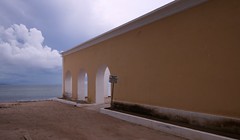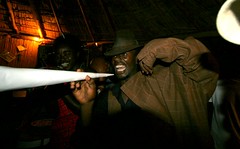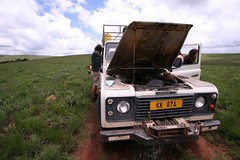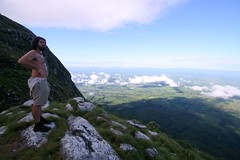I was just going to append this to the previous entry, but since “tomorrow” was a long time ago, here is the rest of the story:
I had just enough time to eat a shitty breakfast at Jey-Jey’s restaurant before we pulled out of Marsabit. Soon I was speeding over the rock-strewn road in a cushy 4x4 with ten other locals.
If the landscape between Isiolo and Marsabit is desolate, here it takes on an other-worldly isolation. The five-year drought has done away with all but a few tufts of the most hearty desert scrub and the nomadic Borana people have almost all moved north into Ethiopia in search of greener pastures. Even some of the famous old “singing wells” are no longer yielding water. What remains of the great plains of northern Kenya is a series of oppressively hot dust bowls punctuated by a few small volcanic peaks. The road, which has never been paved and barely exists in some spots, cuts a nearly straight line through the fields of black volcanic boulders.
Every once in a while we would pass through a tiny village. None of them could have been home to more than a few dozen families, all living in a state of poverty that puts them just a notch above mere survival. Aside from a shop or two with nearly empty shelves, a cluster of round thatch huts roofed with plastic rubbish and maybe a restaurant catering to the few passers-by, there is nothing. The only signs of life outside these outposts are the occasional herds of goats.
For the first three hours of the drive I thought the other passengers were just really friendly - the driver stopped the car for them to chat with every person they saw - but he eventually explained to me that this was a shopping trip for them. In two days there was to be an important ceremony, for which they needed to purchase and slaughter a goat. Unfortunately they didn’t find a suitable one at the right price so I didn’t have the pleasure of spending the rest of the journey in the cramped back seat with an angry goat. Too bad.
We rolled into the Kenyan half of Moyale at around 2pm. I was instantly reminded of the Cambodian town of Poipet at the Thailand / Cambodia border, but even that doesn’t describe the absolute “edge-of-the-world” feeling of Moyale. Generally speaking, border towns tend to be filth and sleaze magnets, and Moyale is no exception. I walked a couple of km’s through town toward the border, trying not to attract any more shady touts, crooked money-changers, prostitutes, begging children or random dodgy characters than was naturally unavoidable.
I have walked across several borders, in Africa and elsewhere. Its a pretty routine procedure, provided you’ve sorted out the paperwork, and is usually quick and painless. The one part, though, that will always make me anxious is changing money with the black market traders.
The situation is always heavily weighted against you: you’re often tired, sweaty and dirty after a long bus / truck ride, you’re naturally ill-informed about up-to-date exchange rates, and you have to concentrate on working out the mathematics of a fair exchange while the pushy, shifty-eyed changers do their best to confuse you. Then factor in the pack of sticky-fingered children hovering around your bags and even the most level-headed traveler can hardly help acting like a paranoid schizophrenic.
Ethiopia presents an added complication: since there are no ATMs in the country which accept Mastercard-branded plastic, I was forced to carry a large wad of cash into the country. I’m happy to report that I did well at the Moyale border - I managed to get slightly better than the official rate while changing $300 worth of Kenyan Shillings into Ethiopian Birr - although it was a stressful experience.
On the other side, the Ethiopian immigration official was a bit confused by my passport and initially told me I couldn’t enter the country.
“I scanned it into computer, says ‘nationality not found.’ Maybe you need new passport?” He indicated the worn out cover and frankenstein hack-job the US embassy in Cairo did with the new set of extension pages. “Maybe you can try again?” I suggested.
He kept trying, but eventually had to make some phone calls to work things out. I finally got my stamp and went on my merry way…
The Ethiopian side of the road is a golden paradise compared with Kenya’s half. Well, not exactly but I felt immediately at ease walking the much calmer streets. I found a cheap hotel and had my first Ethiopian meal: injera, doro wat and a kiddus giorgis beer. After weeks of fried chicken, eggs and chips in Kenya and Tanzania, the food in Ethiopia is indescribably good. Slow-roasted meat, spicy sauces, fresh fruit and vegetables… variety! I slept like a baby and left at 5:00am the next morning for Awasa.







